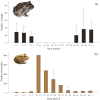Adult-Juvenile interactions and temporal niche partitioning between life-stages in a tropical amphibian
- PMID: 32925925
- PMCID: PMC7489520
- DOI: 10.1371/journal.pone.0238949
Adult-Juvenile interactions and temporal niche partitioning between life-stages in a tropical amphibian
Abstract
Divergence in ecological niche offers organisms the opportunity of exploiting different food and habitat resources, scaling down competition and predation both among species, and within different age or size-classes of the same species. In harsh environments, where abiotic factors determine a clustering of resources during short timespans, competition and predation between organisms is likely to be enhanced. This is the case in tropical dry forests, where amphibians have limited opportunities to feed, their activity being restricted to the short rainy season. One way to maximize resource exploitation while avoiding predation risk is by adopting different diel activity patterns. We tested this hypothesis by comparing activity patterns in adults and recently metamorphosed juveniles of Pacific horned frogs (Ceratophrys stolzmanni) during field surveys and in an experimental study. Field surveys showed that the adults are strictly nocturnal, whereas freshly metamorphosed juveniles can be found active above ground at all hours, with a peak activity during daytime. The average body condition index of juveniles found active during the night was higher than that of juveniles found active during the day, suggesting that the weaker individuals may be constrained to being active during the day. On the other hand, in a laboratory experiment, juveniles that were visually exposed to adults moved less than those in the absence of adults. Both field and experimental observations indicate a temporal niche divergence between life stages. The results of the experiment offer support to the hypothesis that the juveniles in this species display an inverse activity pattern compared to adults, which can reduce competitive interactions and predation pressure from the larger conspecifics.
Conflict of interest statement
The authors have declared that no competing interests exist.
Figures




Similar articles
-
Feeding behavior and aggression in wild Siberut macaques (Macaca siberu) living under low predation risk.Am J Primatol. 2015 Jul;77(7):741-52. doi: 10.1002/ajp.22393. Epub 2015 Mar 2. Am J Primatol. 2015. PMID: 25736828
-
Spatial Niche Segregation of Sympatric Stone Marten and Pine Marten--Avoidance of Competition or Selection of Optimal Habitat?PLoS One. 2015 Oct 7;10(10):e0139852. doi: 10.1371/journal.pone.0139852. eCollection 2015. PLoS One. 2015. PMID: 26444280 Free PMC article.
-
Adult feeding moths (Sphingidae) differ from non-adult feeding ones (Saturniidae) in activity-timing overlap and temporal niche width.Oecologia. 2016 Feb;180(2):313-24. doi: 10.1007/s00442-015-3363-x. Epub 2015 Jun 24. Oecologia. 2016. PMID: 26104275
-
The social structure and strategies of delphinids: predictions based on an ecological framework.Adv Mar Biol. 2007;53:195-294. doi: 10.1016/S0065-2881(07)53003-8. Adv Mar Biol. 2007. PMID: 17936137 Review.
-
Trade-offs, temporal variation, and species coexistence in communities with intraguild predation.Ecology. 2007 Nov;88(11):2720-8. doi: 10.1890/06-1515.1. Ecology. 2007. PMID: 18051639 Review.
Cited by
-
Day-night gene expression reveals circadian gene disco as a candidate for diel-niche evolution in moths.Proc Biol Sci. 2024 Aug;291(2029):20240591. doi: 10.1098/rspb.2024.0591. Epub 2024 Aug 28. Proc Biol Sci. 2024. PMID: 39194299 Free PMC article.
-
Assessment of future habitat suitability and ecological vulnerability of Collichthys at population and species level.BMC Ecol Evol. 2025 Jan 2;25(1):1. doi: 10.1186/s12862-024-02339-7. BMC Ecol Evol. 2025. PMID: 39743516 Free PMC article.
-
Ambush Site Selection by a Green Bamboo Pit Viper: Relation to Prey Abundance and Comparison between Juveniles and Adults.Zool Stud. 2024 Dec 25;63:e55. doi: 10.6620/ZS.2024.63-55. eCollection 2024. Zool Stud. 2024. PMID: 40933663 Free PMC article.
-
Size-Mediated Trophic Interactions in Two Syntopic Forest Salamanders.Animals (Basel). 2023 Apr 7;13(8):1281. doi: 10.3390/ani13081281. Animals (Basel). 2023. PMID: 37106844 Free PMC article.
References
-
- Chase JM, Leibold MA. Ecological niches—linking classical and contemporary approaches. Chicago, Illinois, USA: University of Chicago Press; 2003.

